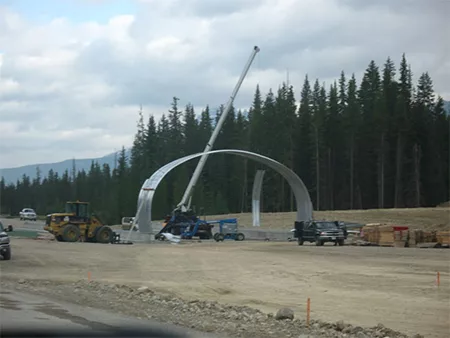Since 1987, when the first animal bridge was completed, six overhead bridges have been completed in the park. Along with quite a few more under-the-highway tunnels and pathways, and animal fencing on both sides of the highway.

In 1980, the entire stretch of the Trans-Canada through Banff National Park was a 2-lane highway. The government was looking at improving safety for the ever-increasing vehicle traffic, to reduce head on collisions, as well as making the highway safer for the wide range of wild animals residing in the park.
Since the 1980s, the Canadian government has allotted more than $400 million to upgrade and twin the four-lane highway, and it has allocated a quarter of the budget set aside for projects that would reduce wildlife collisions, a growing concern as the traffic is projected to keep increasing. Banff National Park gets about 6 million visitors a year.
Parks Canada has fenced the entire 180 kilometres of highway through the park and built several dozen wildlife crossing structures to lower the mortality rate. Before the fencing and structures, wildlife would wander onto and cross the highway, and were hit, wounded, or killed by the fast-moving automobile and truck traffic to and through the park. There were 100 elk-vehicle collisions per year in the mid-1990s before the fencing was completed.
While the animal bridges are the most visible, and the preferred crossing routes for deer, elk, and grizzlies, there are 38 tunnels and culverts under the highway that seem to be preferred by black bears and by mountain lions.
There are also 6 animal bridges (and one more is planned east of the park, near Canmore) that cost $2-3 million each to build. These structures also have motion-detector activated cameras and have tracked over 200,000 animal crossings by both large mammals and animals as small as toads. Some species took as long as 5 years to feel safe and secure on the animal bridges.
To build the bridges, the surface needs to be prepared, then an upside-down culvert is installed over the traffic lanes, then then area between and beside the culverts is built up from stone and earth to create the gentle slope and sightlines that animals need to cross the highway. Animal fencing is installed on the sides of the bridge, to keep animals on the bridge. Then, to blend them with the surrounding wilderness, the animal bridge surface is planted with trees, shrubs, grasses, and mosses. Finally, the animal fencing on both sides of the highway is opened and connected with the animal bridge fencing, so animals can learn to cross safely.

Here is a map of animal bridge locations in Banff National Park. Most of these are double-culvert structures, with one culvert crossing over each direction’s two lanes. The bridge west of Lake Louise is a large one, that crosses all four lanes of traffic with a single culvert.

TCH- Animal Bridge Locations in Banff National Park


